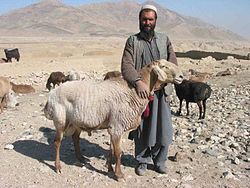Type the name of the breed you're looking for below
[wpdreams_ajaxsearchlite] Don't see the breed your're looking for? Click here and let us know!
Balkhi sheep
| Place of Origin | Afghanistan |
| Origin | The Balkhi is a domesticated breed of sheep found in Afghanistan and North-western Pakistan. This breed is of the fat-tailed mutton type. Though this breed does grow wool, it is primarily raised for meat. |
| Purpose | Meat, Fiber |
| Characteristics | The Balkhi displays black, tan or grey. They yield approximately 2 kg (4.4 lb) of coarse wool with an average 43.5 micrometre diameter. This breed has a low fiber density. The ears are somewhat long, the body is muscular and compact. The tail is fat and tucked. Both sexes are horned. On average at maturity, rams weigh 70 kg (150 lb) and ewes 70 kg (150 lb). Rams grow to approximately 87 cm (34 in) and ewes 74 cm (29 in) at the withers. Ewes lactate for about 105 days and produce 60 kg (130 lb) of milk on average during this period. At birth, rams weigh 5.2 kg (11 lb) and ewes weigh 3.8 kg (8.4 lb). |



